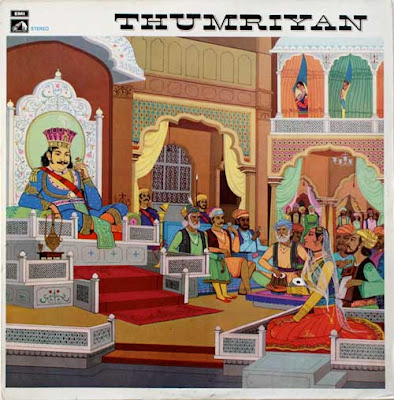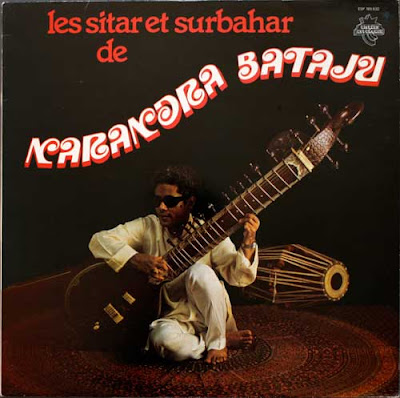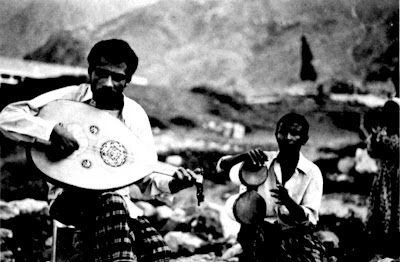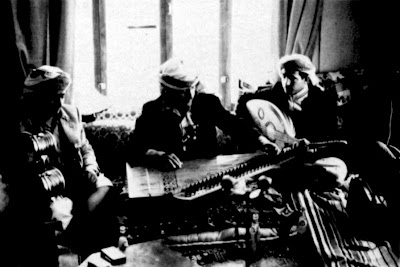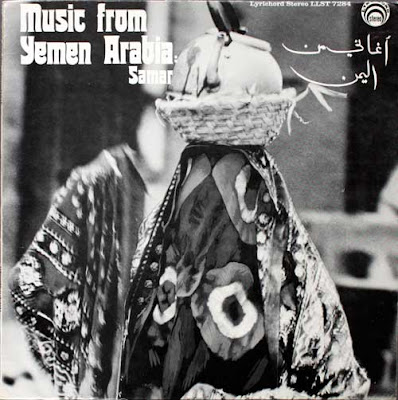ThumriyanEMI India - ECSD 2748 - P.1975
Side A
A1 Nirmala Devi • Ro Ro Nain Ganwaye Sajna Na Aaye
- Mishra Shivranjini - Kaharwa Taal 6'38
A2 Hira Devi Mishra • Mora Saiyan Bulawe Adhi Raat
- Des - Kaharwa Taal 6'53
A3 Girja Devi • Nahak Laye Gawanwa
- Bhairvin (purab ang) Deepchandi Taal 6'52
Side B
B1 Parween Sultana • Tum Radhe Bano Shyam
- Pilu - Deepchandi Taal 6'46
B2 Lakshmi Shankar • Shyam Bina Nahin Chain
- Khamaj - Deepchandi Taal 6'58
B3 Shobha Gurtu • Chhod Gaya Sajan Mera
- Bhairvin (purab ang) Kaharwa Taal 6'38
![]()
I promised long ago already to post more of Hindustani Female vocalists so here is a quick attempt at that. Hope you like what you hear some are better than the others of course. And I have still to post some more of the real greats. We had one record by Kerkar Bai but there are many more worthy singers to post. Do not despair, they will come! Already ripped but in various stages of readiness lies already many LP's in line waiting to be posted by these great singers:
Begum Akhtar, Gangubai Hangal, Roshan Ara Begum, Hirabai Barodekar, Azam Bai, Malini Rajurkar, Girja Devi, Sunanda Patnaik, Siddheswari Devi,
Prabha Atre, Shoba Gurtu, Kishori Amonkar, Lakshmi Shankar, Parween Sultana. Some of them are represented in this post but this is the lighter repertoire of Thumri, so you can expect some of the others to catch your deeper emotions and this hopefully to be pleasant to your ears! Hope you enjoy!
Nirmala Devi
Nirmala (Nazeem) Ahuja (born. 19?? and left us long ago) She was one of the finest thumri singers following the Patiala tradition under U. Abdul Rehman Khan. She was also the mother of the famous indian cinema actor Govinda.
We know the above from the kind correction of one of our visitors here, Dr. Kashyap. Thank you for putting us right! Thanks to his mentioning of the cinema actor Govinda, who was her son we were also able to find the following information:
Govinda’s father, Arun Kumar Ahuja, was born in pre-partition Gujranwala, Punjab (now in Pakistan) on January 26, 1917. He studied in an engineering college at Lahore. Veteran producer Mehboob Khan brought him to Mumbai in 1937 and cast him in Ek Hi Raasta as the leading man. Arun was notable for acting in Mehboob Khan's Aurat (1940). Govinda's mother, Nazeem who was Muslim had converted to Hinduism and adopted the name Nirmala Devi. Arun and Nirmala first met during the making of the film Savera, in which they were cast opposite each other. They married in 1941.
The only film Ahuja ever produced was a flop. Unable to bear the loss, his health failed. The family, living in a bungalow on Mumbai's upmarket Carter Road, later moved to Virar — a northern Mumbai suburb, where Govinda was born. The youngest of six children, his pet name Chi Chi means little finger in Punjabi, the language they speak at home. Since his father was unable to work, Nirmala Devi brought up the children through hard times in Mumbai.
from Wikipedia (full text here)
(I will try to add dates and more information later as I find them!)
Hira Devi Mishra
I really cannot find any information of substance on this artist more than that she taught at Banares. and some song titles from various films. If you feel like it please help out.
Girja Devi
Girija Devi (Hindi: गिरिजा देवी; IAST: Girijā Devī) (born 1929) is an Indian classical singer of the Banaras gharana. She performs classical and light classical music and has helped elevate the profile of thumri.
Girija Devi was born in Varanasi, India in 1929. Her father played the harmonium and taught music, and had Devi take lessons in singing khyal and tappa from vocalist and sarangi player Sarju Prasad Misra starting at the age of five. She starred in the movie Yaad rahe aged nine and continued her studies under Sri Chand Misra in a variety of styles.
Devi made her public debut 1949 on All India Radio Allahabad, after getting married to a businessman circa 1946, but faced opposition from her mother and grandmother, because it was traditionally believed that no upper class woman should perform publicly. Devi agreed not to perform privately for others, but gave her first public concert in Bihar in 1951. She studied with Sri Chand Misra until he died in the early 1960s, worked as a faculty member of the ITC Sangeet Research Academy in Kolkata in the 1980s and of the Banaras Hindu University during the early 1990s, and taught several students to preserve her musical heritage. Devi often toured and continues to perform in 2009.
Devi sings in the Banaras gharana and performs the purabi ang thumri style typical of the tradition, whose status she helped elevate. Her repertoire includes the semi-classical genres kajri, chaiti, and holi and she sings khyal, Indian folk music, and tappa. The New Grove Dictionary of Music and Musicians states that her semi-classical singing combines her classical training with the regional characteristics of the songs of Bihar and eastern Uttar Pradesh.
Parween Sultana
Begum Parveen Sultana (born 1950) is an Assamese Hindustani classical singer of the Patiala Gharana. She is among the foremost classical vocalists in India. She was conferred the Padmashri in 1976.
Parveen Sultana was born at Daccapatty in Nowgong town , Assam, India to Ikramul Mazid and Maroofa Mazid. She went to Mission School . Her father, late Ikramul Mazid was her first guru and he was very strict with her. She also received early training from her grandfather Mohammed Najeef Khan, a pathan . She later went to Kolkata to learn to learn music under the guidance of late Pandit Chinmoy Lahiri and from 1973, she became a disciple of Ustad Dilshad Khan of the Patiala Gharana.
Lakshmi Shankar
Lakshmi Shankar (born 1926) is a Hindustani classical vocalist of the Patiala Gharana. She is known for her performances of khyal, thumri, and bhajans.
Born in 1926, Lakshmi started her career in dancing. In 1939, when Uday Shankar brought his dance troupe to Madras, (recently renamed Chennai), she joined the Almora Centre to learn Uday Shankar’s dance style based on the Indian classics, and became a part of his troupe. She later married Uday Shankar's brother, Rajendra (with nickname Raju). During a period of illness, Lakshmi had to give up dancing, and already having had a background of Carnatic music, she undertook learning Hindustani classical music for many years under Ustad Abdul Rehman Khan. Later, she also trained with Ravi Shankar, the sitar maestro. Shankar toured America with Ravi Shankar and George Harrison in 1974. After Ravi Shankar's heart attack she conducted his touring band.
Lakshmi has shown her versatility and adaptability by composing music for Bharatanatyam for the leading dance company Shakti School of Bharatanatyam located in Los Angeles.
Shobha Gurtu
Shobha Gurtu (Hindi: शोभा गुर्टू) (1925 – 2004) an Indian singer in the light Hindustani classical style. Though she had equal command over pure classical style, it was with light classical music that she received her fame, and in time came to be known as the Thumri Queen, and for the ‘Abhinaya’ ang in her full-throated voice
Bhanumati Shirodkar was born in Belgaum, (present Karnataka) in 1925, she was first trained by her mother Menekabai Shirodkar, a professional dancer, and a 'gayaki' disciple of Ustad Alladiya Khan of the Jaipur-Atrauli gharana.
Though her formal music training began with ‘Ustad Bhurji Khan’, the youngest son of Ustad Alladiya Khan, the founder of the Jaipur-Atrauli gharana in Kolhapur, from whom her mother was learning at the time, while she was still a younger girl, and seeing her talent, Ustad Bhurji Khan’s family immediately took a liking of her, and she started spending long hours with them. Her ties with the Jaipur-Atrauli gharana were to strengthen still, when she started learning from, Ustad Alladiya Khan’s nephew Ustad Natthan Khan; though she really came into her own under the tutelage of Ustad Ghamman Khan, who came stay with their family in Mumbai, to teach her mother thumri-dadra and other semi-classical forms.
Shobha Gurtu specialized in semi classical forms as thumri, dadra, Kajri, Hori etc., effortlessly adding pure classical passages into her singing, thus creating a new form, and reviving the magic of forms like, Thumri, of which she became a greatest exponent in time. She was particularly influenced by singer Begum Akhtar and Ustad Bade Ghulam Ali Khan.
She also performed music in Marathi and Hindi cinema. As a playback singer, she first worked in Kamaal Amrohi’s film, Pakeezah (1972), followed by Phagun (1973), where she sang, ‘Bedardi ban gaye koi jaao manaao more saiyyaan’. She earned a Filmfare nomination as Best Female Playback Singer for the song “Saiyyan Rooth Gaye” from the hit film Main Tulsi Tere Aangan Ki (1978). In Marathi cinema she sang for films like Saamna and Lal Mati.
Over the years, she travelled all over the world for concerts, including at one the Carnegie Hall, New York City, performing alongside musical greats and, Pt. Birju Maharaj. She often lend her voice the collaborative jazz albums, of her son Trilok Gurtu. In 2000, she featured in the Jana Gana Mana Video, which was released to mark the 50th year of the Indian Republic, where she sang the Indian National Anthem, Jana Gana Mana, along with other leading classical singers and musicians of India.
In 1987, she received the Sangeet Natak Akademi Award, and later awarded the Lata Mangeshkar Puraskar, Shahu Maharaj Puraskar and the Maharashtra Gaurav Puraskar. In 2002, she was awarded the Padma Bhushan.
After reigning over Hindustani classical music genre, for five decades, as the Queen of Thumri, Shobha Gurtu died on 27 September 2004, and was survived by her two sons.
pinched from the Wikipedia
“Words are bound in chains, while happily sounds are still free” — so once declaimed Ludwig van Beethoven. What he said of music in general is specially true of thumri, one of the most enchanting forms of musical expression in the Hindustani tradition.
Aptly described as the expression of the singer's soul and temperament, thumri is purely romantic or devotional in its content. Unlike Dhrupad and khayal, the stress in thumri-singing is not so much on the melodic unfoldment as on the portraiture of the mood enshrined in the lyric. Imagination thus plays a vital role in the rendition of thumri. It calls for a sense of restraint and discrimination on the part of the singer, as the expressive aspect of the poetic theme is basic to its delineation. The singer has to comprehend the lyrical motivations of the chosen song to be able to give full musical expression to the emotion it embodies.
Voice modulation and delicate intonation are two of the many vital features of thumri, and the artiste is allowed freedom to employ a variety of ornamentations such as “meend”, “murki”, “kan”, “khatka”, “zam-zama” and the like in projecting the mood of the theme.
The word thumri is derived from “thumak” (graceful stamping of the foot). It is also said to have been derived from a combination of the terms “thumak” and “rijhana” Thus it connotes association with dance. Thumri came into vogue in the eastern region (Purab) of Uttar Pradesh towards the close of the 18th century as an accompanying song of dance. The object was to make dance movements more expressive and abiding.
Primarily, the emergence of thumri can be said to have symbolised a kind of reaction to its percursor, khayal, in which combinations of musical sounds enjoyed precedence over the poetic aspect of song-themes. But it is equally significant to note that this period also marked the twilight of the Mughal rule. The princely patrons of music, lolling in luxury, now had little use for sombre, dignified musical entertainment. Their obsessive fondness for fun and frolic brought forth a new style that could pander to their whims and caprices in a variety of ways.
Thumri thus found a congenial atmosphere during the reign of Nawab Wajid All Shah of Avadh. He was probably the greatest known patron of thumri, “raas” and the Kathak dance. Every year, he organised a big “raas” show with the sport of Lord Krishna and the gopis as the theme. The Nawab himself, with his consuming passion for poetry and music, took an active part in the presentation. Any talented artiste could participate in this song-and-dance concert with the obvious preponderance of young women among the participants. They depicted their “nrityabhava” and also offered their “mujra” through thumri songs. Thumri thus was once the exclusive preserve of female singers, and came to be conventionally known as a feminine style "par excellence"
A composer of no mean merit, Nawab Wajid Ali Shah wrote under the name of Akhtar Piya and patronised masters of the eminence of Kudau Singh Pakhwaji and Maharaj Binda Din, the pioneering Kathak maestro. The impressive line-up of thumri composers also includes Kalika Prasad who, along with his brother, Bindadin, composed thumris that were suitable for “nritya bhava” and presented them through their dance. Kadar Piya, Daras Piya, Lalan Piya and Chand Piya were other luminaries who pioneered and enriched this form.
Lucknow and Varanasi (Benaras) are the two centres from where thumri evolved into several varieties. In the style that is in vogue in Lucknow know, the subject-matter of thumri is usually an Urdu poem or ghazal, while in Benaras, tappa is more prevalent. “Bol-bant ki thumri” lays stress on rhythm which is “thumak”, while “artha-bhava ki thumri” has more of “rijhana”. The combination of both is found in the “bol-banao” variety. On the other hand folk and Pahadi tunes seem to have influenced the Punjabi variety of thumri, a relatively modern development.
The ragas most commonly suited to thumri-singing are Bhairvin, Jhinjhoti, Khamaj, Pilu, Des, Tilak Kamod, Kafi, Jogia, Tilang, Ghara and Bihari, and the talas which are employed are deepchandi, chachar, teental, sitar-khani, punjabi theka and addha.
The credit for popularising the Purvi style goes to Bhaiya Ganpat Rao, Moizuddin Khan, Pyare Sahib, Zohra Bai, Janki Bai, Badi Moti Bai, Rasoolan Bai, Vidyadhari Bai, Siddheswari Devi and Begum Akhtar. These are indeed the names to conjure with in the field, while Bade Ghulam All Khan and his brother, Barkat All Khan, who achieved a subtle blend of popular Punjabi folk airs with the orthodox features of purvi thumri, gave new dimensions to this singing style.
The six artistes heard in this disc are among the most popular exponents of thumri today. The repertoire will capture the hearts of thumri connoisseurs and bring back to their minds the nostalgic memories of old masters.
notes above from the backside of the sleeve
![]() Music ▼ +
Music ▼ +







